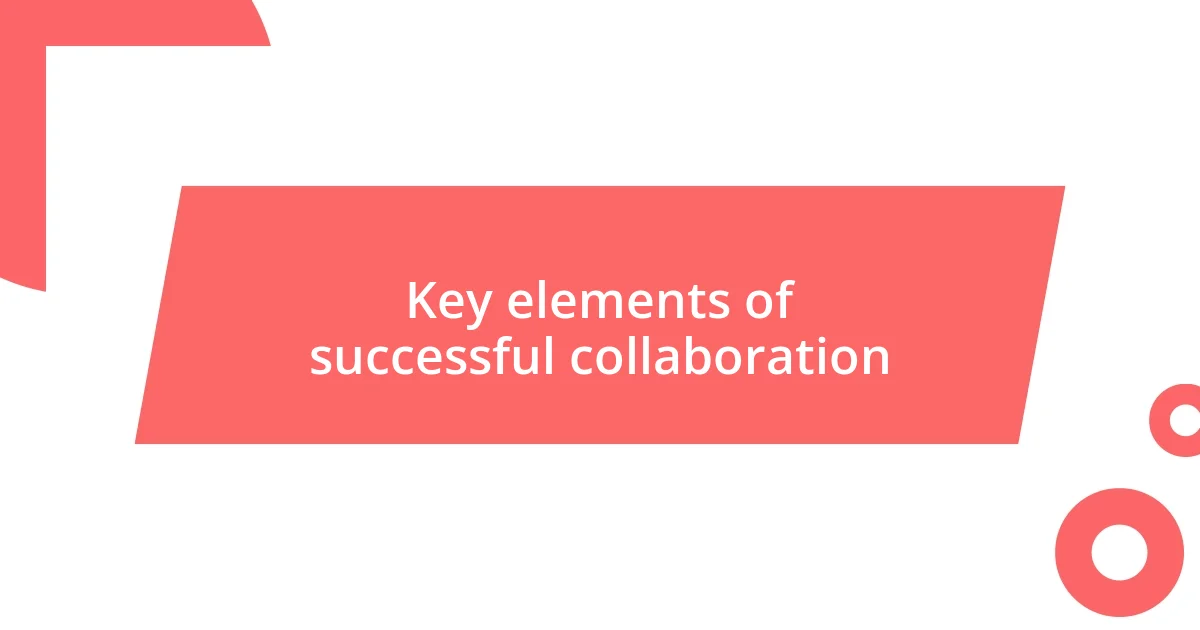Key takeaways:
- Ensemble collaboration fosters trust, communication, and deep connections, enhancing creativity and performance quality.
- Key elements of successful collaboration include open-mindedness, accountability, and celebration of individual contributions.
- Challenges like differing artistic visions and vulnerability can lead to personal growth and stronger team dynamics when navigated effectively.

Understanding ensemble collaboration
Ensemble collaboration is the heartbeat of theater, where each member contributes their unique talents and perspectives. I remember stepping into my first rehearsal, a mix of excitement and anxiety bubbling within me. How would I fit into a group where everyone seemed so skilled? It turns out, the beauty of ensemble work lies in its ability to create a safe space for exploration and vulnerability.
When I think of ensemble collaboration, I often reflect on late-night sessions where we’d laugh, argue, and ultimately grow together. These moments forged deep connections that made our performances resonate with authenticity. Have you ever experienced the magic that comes from shared creativity? It’s a feeling that transforms not just the performance but also our relationships with each other.
I’ve learned that effective ensemble collaboration thrives on trust and communication. In one production, we set aside time at the start of each rehearsal to check in with one another. It was a simple practice, yet it opened the floodgates to honest conversations that strengthened our bond. How do you nurture trust within a team? I’ve found that it’s often these small gestures that elevate the entire experience, allowing our collective energy to shine on stage.

Importance of collaboration in theater
Collaboration in theater is vital because it fuses diverse skills and ideas into a cohesive performance. I still remember a moment from a production where one actor suggested a completely different approach to a scene. At first, I hesitated, afraid it might alter the character’s essence. But once we embraced that fresh perspective, the scene transformed into something breathtakingly powerful. That, to me, encapsulates how collaboration can push boundaries and elevate the entire production beyond what any individual could achieve alone.
Here are some key points reflecting the importance of collaboration in theater:
- Shared Vision: Collaboration helps create a unified artistic vision that resonates with the audience.
- Enhanced Creativity: Diverse viewpoints lead to innovative ideas, enriching the performance.
- Stronger Bonds: Working together fosters trust, building lasting relationships that enhance stage chemistry.
- Problem Solving: Teams that collaborate can tackle challenges more effectively, finding creative solutions together.
- Personal Growth: Collaborating exposes individuals to different skills and approaches, promoting personal and professional growth.

Key elements of successful collaboration
When I think about successful collaboration in theater, I can’t help but emphasize the role of open-mindedness. Each rehearsal becomes an opportunity to embrace different viewpoints, like when a fellow actor suggested a whimsical twist to a serious scene. Initially, I felt resistance, but that very suggestion sparked a creativity in me that I didn’t know existed. Isn’t it incredible how a single idea can reshape the narrative and deepen the character’s journey? This is why flexibility is a cornerstone of ensemble collaboration.
Equally important is the element of accountability. In one show, we assigned each other specific roles during rehearsals, creating a sense of ownership that transformed our group dynamics. I recall one instance where I fell behind in my lines, and the supportive nudges from my colleagues pushed me to step up my game. It’s fascinating how knowing that others depend on you fosters not just responsibility but also a commitment to collective excellence. Have you ever been part of a team where the pressure to succeed together invigorated you?
Lastly, let’s not overlook the significance of celebration in collaboration. After a grueling week of rehearsals, we would always take the time to acknowledge each person’s contributions, big and small. One evening, we even celebrated an actor’s birthday after a particularly tough session. That shared joy not only lifted our spirits but also reinforced our commitment to each other. So, how do you celebrate successes in a group setting? I believe these moments of recognition are the glue that holds collaborations together, illuminating the journey we take together on stage.
| Key Element | Description |
|---|---|
| Open-mindedness | Embracing diverse viewpoints enriches creativity and innovation. |
| Accountability | Ownership of roles fosters commitment and boosts team performance. |
| Celebration | Acknowledging contributions strengthens bonds and motivates the ensemble. |

My personal journey in theater
My journey in theater began with a school production that left a lasting impression. I was nervous, standing backstage, clutching my script as the lights dimmed. But when I stepped into that spotlight, I felt an exhilarating rush. That moment was intoxicating, and it made me realize how deeply I craved the thrill of collaboration. Have you ever felt that spark when working alongside others? For me, it was the beginning of a profound love for ensemble work.
As I delved deeper into the theater world, I cherished the unique friendships that blossomed. I vividly remember a late-night rehearsal where we hashed out a particularly challenging scene. Between laughter and shared ideas, we created something memorable together. I often find myself reflecting on how those connections enriched my experience, reinforcing the idea that collaboration in theater is not just about the performance itself, but the bonds we forge along the way.
One specific production stands out, where I took on a supporting role that didn’t initially resonate with me. I worried about being overshadowed, but then an ensemble member encouraged me to find my own light. As I embraced my character, I discovered not just my contribution to the story but also my own personal growth. Isn’t it incredible how stepping outside your comfort zone can lead to unexpected transformations? That experience taught me the true power of collaboration—not just in the act of creation, but in the journey of self-discovery it offers.

Challenges faced during collaboration
Collaboration in theater, while rewarding, comes with its fair share of challenges. One hurdle I faced was differing artistic visions among ensemble members. I remember a rehearsal where two actors had opposing interpretations of a pivotal scene, and it led to a heated discussion. Navigating those passionate perspectives wasn’t easy, but it ultimately pushed us to refine our ideas and find a middle ground that served the story.
Another challenge is managing the tempo of rehearsals. I recall an experience where I was eager to move forward with blocking, but the pacing felt off because some team members struggled with their lines. It’s a delicate balance—like a dance, really. I had to remind myself that we were in this together, and patience became an essential part of our collaboration. Have you ever felt that tension where progress clashes with the need for thoroughness? It’s a natural part of the creative process.
Lastly, I often grappled with vulnerability in the ensemble. Sharing your interpretation of a character can be daunting, especially when you fear it might not resonate with others. I vividly remember feeling exposed during one rehearsal, sharing my personal connection to a role that was vastly different from who I am. Surprisingly, that vulnerability fostered deeper connections with my castmates. Why do you think revealing our true selves can be so daunting yet rewarding? For me, it’s a testament to the profound trust that forms in the collaborative environment of theater.

Techniques for effective teamwork
Effective teamwork in theater requires clear communication. I’ve seen how setting aside time for dedicated discussions can drastically improve collaboration. Just recently, after a particularly intense rehearsal, my team and I gathered for an open dialogue. We shared our thoughts on the scene adjustments, and it felt like a breath of fresh air, transforming tensions into understanding. How often do we overlook the power of simple conversation?
Another technique I’ve found invaluable is embracing the diverse strengths of ensemble members. During one production, I was paired with a fellow actor whose improvisational skills far exceeded mine. Instead of feeling intimidated, I sought her guidance. Through her, I not only learned new techniques but also discovered my own potential for spontaneity. Isn’t it fascinating how leaning on each other’s unique talents can elevate the entire group’s performance?
Lastly, fostering a culture of mutual support is crucial. I remember a performance where we faced unexpected technical difficulties. Instead of panicking, my fellow cast members rallied together, creating a supportive atmosphere that allowed us to adapt seamlessly. This sense of solidarity reminded me that in theater, every challenge is a shared experience. Can you recall a moment where teamwork turned a potential disaster into a memorable triumph? It’s those moments that truly encapsulate the essence of ensemble collaboration.

Lessons learned from ensemble experiences
One key lesson I learned from ensemble experiences is the significance of active listening. There was a moment during a rehearsal when one of my team members shared an emotional story related to their character. It struck me how much deeper our scene became simply because we took the time to listen to one another. Have you ever noticed how a small act of attentiveness can transform the dynamics of a group? It illuminated for me that understanding someone else’s perspective can enhance not just the performance, but our connections as a team.
Additionally, the concept of flexibility proved invaluable. I recall an instance when a beloved scene had to be cut due to timing constraints. Initially, I was disheartened, feeling as though part of my work was erased. But as we reworked the remaining scenes, I found unexpected joy in watching ideas flourish from the ashes of my disappointment. How often do we hold onto something so tightly that we miss the opportunity for growth? I realized that letting go can lead to new pathways in creativity—both for myself and my ensemble.
Finally, embracing failure as a learning tool became a cornerstone of my development. There were nights when performances didn’t go as planned, and I felt embarrassed. But reflecting on those moments helped me understand that each stumble held a lesson. Have you ever found yourself questioning your abilities after a setback? For me, these experiences brought clarity and resilience. They taught me that every misstep contributes to a richer tapestry of performance—one that includes the beauty of imperfection.














